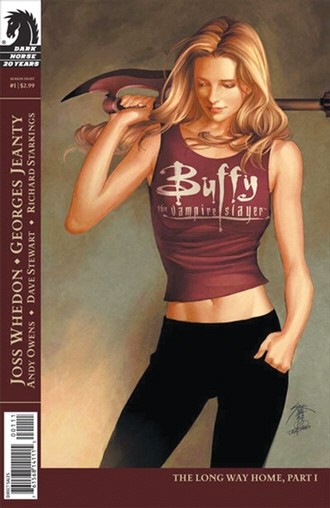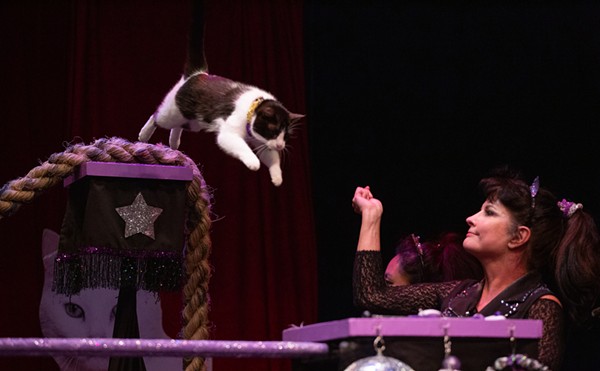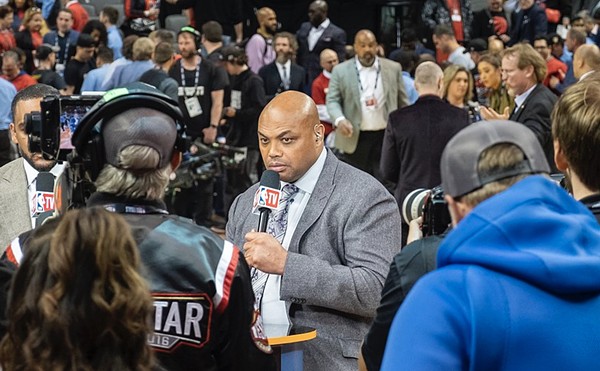| Our favorite vampire slayer is back and intact, with a posse of new slayers to help fight the black-op Initiative. Courtesy image. |
Written by creator Joss Whedon and gorgeously drawn by Georges Jeanty, whose past work on assorted X-Men, Neil Gaiman’s Lady Justice, and Wonder Woman books make his employment here feel preordained, the comic picks up four years after the TV show ended with Buffy saving the world (again) by destroying the Hellmouth, that demon portal in Sunnydale, California — although rumor has it there’s one in Cleveland — and finds our heroine stationed in Scotland.
|
Buffy the VampireSslayer: The Long Way Home, Part 1 By Joss Whedon and Georges Jeanty Dark Horse Comics |
Along with a mess of new slayers in saucy outfits “activated” at season seven’s close, Buffy’s assisted in her newly global anti-evil work by ex-Watcher Giles, blue-collar pal Xander, and Andrew, the sexually ambiguous reformed dork-baddie of Season 6. And not to worry — beloved witch Willow will appear (we’re telling you exactly nothing about her grand entrance), although Buffy’s sister Dawn is temporarily sidelined due to her suffering a mystical ailment that hilariously makes literal fans’ complaints about her being a big baby.
Anyway, and as per pleasurably familiar usual, a demonic presence threatens. What the Buffy group doesn’t know is that that the U.S. military may, in fact, be in league with the forces of darkness and is planning to — well, we’ll return to that in a moment. Fanboy gush aside, it’s worth a look at why Buffy is still a viable enterprise, and perhaps even that rare pop icon that transcends medium. The core of its enduring validity has a great deal to do with the fact that Buffy has always been reflectively political, whether in its obvious, if eccentric, feminism; its consistent endorsement of nuclear-family alternatives represented by the flexible core group of Buffy friends; its reflexive mistrust of anything patriarchal or authoritarian; and/or its presentation of network TV’s first lesbian sex scene.
The Long Way Home doesn’t represent the first time Buffy’s run afoul of the military-industrial-black-magic complex: Back in 1999’s Season 4, she defeated a black-op called the Initiative that was hellbent on creating a human-demon supersoldier. Like clockwork, the new Buffy reflects current reality, that lousy one in which the world-dominance-drunk neoconservatives famously dismissed by George H.W. Bush as “the crazies in the basement” run everything disastrously.
And so the Initiative’s small cabal has morphed, in The Long Way Home, into a vast militarist elite that’s learned zip from past defeats and views Buffy’s group of dedicated humanists as a terrorist cell defined by “a hard-line ideology that does not jibe with American interests.” Its solution is typically draconian: kill Buffy, and so decapitate her movement of outsiders and uppity feminists in cool outfits. Actually, the situation is even worse — recall our mention of the military being in bed with dark forces? — but giving away particulars would be unforgivably spoiler-y.
Anyway, it’s Buffy’s ability to create an ongoing, hugely entertaining conversation with current fears and hopes in supernatural drag that may allow it to join Batman, Superman and, yes, Wonder Woman as a text with so much cultural energy it almost can’t help but manifest in whatever forum’s available. With Whedon helming things, it confirms our suspicions — OK, hopes, too — that the epic tale didn’t end with Sarah Michelle Gellar’s Mona Lisa smile in the show’s last image. Hell, based on all the plummy stuff in just the first two issues, the story’s just starting.
All the above wouldn’t be worth jack without Whedon’s characters, who’ve grown up but at their core are still the same ridiculously lovable outsiders we’ve relished since back when the Spice Girls had hits. Xander still confuses his libido with his mission while doting on Nick Fury minutia. Andrew multitasks a demon raid with a hilarious discourse on Lando Calrissian’s space-pimp wardrobe. And Buffy still quips post-vamp-staking, worries about her hair, and agonizes over her losses.
But Buffy just
wouldn’t be Buffy without said characters’ artful mangling of the King’s English, something that’s especially savory in print. And so it’s with dork delight we read and reread Buffy’s explanation of slayers’ powers: “One slayer fighting alone is formidable. Two is formidabler. Or — three? Mega-formidable. And after mega, it goes to mondo, then super, hyper, beucoup d’, crazy, stupid — it gets exponentially prefixy.” Even for normal folks, such prattle is funny stuff. But for us, the fans, it’s the smart/loopy language of true geek love.


















